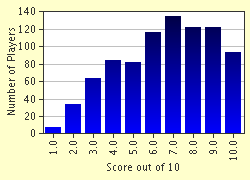Quiz Answer Key and Fun Facts
1. Small microscopic projections in the walls of the small intestine are called which of these?
2. The gastrointestinal tract begins where?
3. Which of these is longer - the small intestine or the large intestine?
4. What gastrointestinal condition consists of an abnormal accumulation of fluid in the abdomen?
5. What is the ring of muscle at the distal end of the stomach called?
6. What is peristalsis?
7. This surgical procedure removes fluid from the peritoneal space.
8. Which is not a part of the small intestine?
9. What order of the large intestine sections is correct, starting from the ileum and ending at the anus?
10. Which of these laboratory test abbreviations has nothing at all to do with the gastrointestinal tract?
Source: Author
Shauna_B
This quiz was reviewed by FunTrivia editor
crisw before going online.
Any errors found in FunTrivia content are routinely corrected through our feedback system.

